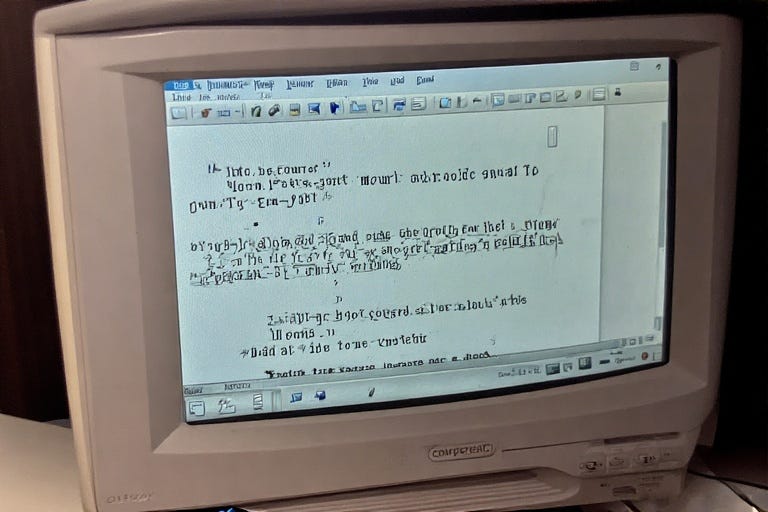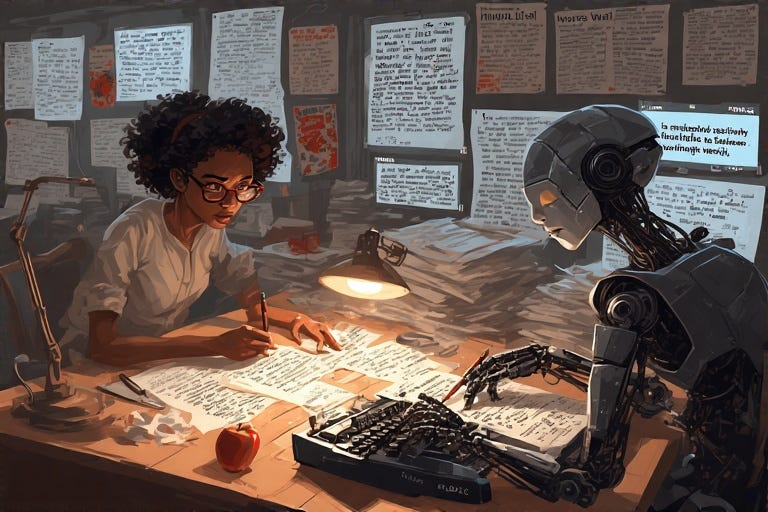Earlier this year, Prompting Culture ran human-written and AI-generated text through AI detection tools. The results were mostly what you would expect: AI text was often—but not always—flagged, while human-written text was not. One reader shrugged: “Can’t you just count em dashes?” Turns out, they weren’t wrong.1
The em dash (—) is now a cultural proxy war. AI tends to overuse it. HR teams sometimes flag it in resumes. Writers delete it to avoid looking like bots. Yet we all appreciate it—because few marks capture human thought’s unpredictability like a well-placed dash.
This is not just a matter of punctuation. Hidden behind these inoccuous horizontal line segments, there’s a fight going on. It’s about who controls rhythm, nuance, and the right to sound human when bots write 90% of your social media feed.
A Brief History of —
The em dash wasn’t born—it was forged. Its origins trace back to early modern printing, where typesetters shaped punctuation to suit the needs of the page.
Named for its width—equaling a capital "M" in metal type—the em dash offered writers and printers a flexible way to signal interruptions, asides, and abrupt shifts in thought: "The vote passed—despite protests—at midnight." Over centuries, it found a home in newspapers, literature, and advertising, becoming a versatile mark favored for both clarity and style.
Then came the typewriter. Early models—like the Remington No. 2 (1878)—had no key for the em dash—a practical omission, as engineers prioritized letters and basic punctuation. Writers adapted by using double hyphens (--), a workaround that became standard for decades. As Lynne Truss reminds us, punctuation is what separates clarity from confusion, and while the double hyphen was a useful hack, it was always a compromise—a reminder of the machine’s limits and the writer’s persistence to preserve rhythm and meaning.
The personal computer era resurrected the true em dash. Word processors (WordPerfect, Microsoft Word) auto-converted -- into —, a tiny act of digital reparation. Suddenly, lawyers drafting contracts, novelists crafting dialogue, and journalists filing under deadline could wield dashes with ease.
Although—as with any technical leap forward—just because they could, doesn’t mean they should. Typographers like Robert Bringhurst dismissed em dash overuse in The Elements of Typographic Style (1992), arguing spaced en dashes (–) were a better choice. The criticism revealed a cultural rift—the dash was always more than punctuation. Maybe it was somewhat of a class signifier—brash, defiantly anti-establishment.
Today’s "AI suspicion" is just the latest battle in this war.
“The em dash is the duct tape of punctuation. AI uses it to patch weak ideas. Humans use it to smuggle subtext.”
—Churchill, probably. Or Einstein. Look, it has no em dashes, so it must be a real human quote 🤷♂️
The Anti-AI Aesthetic
We’ve entered an era where "authenticity" in writing is policed by machines. Detectors search texts for fingerprints of humanity—ironically, often mislabeling our old productions as robotic. The em dash is Exhibit A. Its current vilification reveals a deeper tension—AI’s quest for frictionless efficiency versus humanity’s embrace of messy meaning.
Consider how Large Language Models operate. They generate text by predicting the most likely next words, smoothing jagged edges into polished coherence—ideally. Dashes—spontaneous, interruptive, asymmetrical—represent everything these systems tend to avoid. When experts analyze GPT-4’s writing, they note its preference for safe, conventional grammar. Semicolons and parentheses often appear less fluid, as if the model hesitates to take punctuation risks. The dash? It’s sometimes used as a quick fix—a way to mimic natural pauses without fully mastering rhythm.
This isn’t an accident. It’s baked into the training data. As computational linguist Emily M. Bender has argued, LLMs are trained only on the form of language, not its meaning—they can mimic the style of centuries of literature without truly understanding its content. So when an AI encounters em dashes, it recognizes a pattern to be replicated, not a gesture of breath or rebellion. The result is a kind of dash inflation: AI sometimes peppers its writing with dashes, not out of poetic intent, but as a byproduct of pattern-matching on a massive scale.
Yet here’s the paradox. When humans use dashes well, they achieve effects that AI still struggles to replicate:
Creating pause and emphasis: A dash can signal a meaningful pause or shift in thought. For example: "The truth is—you knew already—he never loved you." The dashes highlight tension and subtext in a way that AI-generated text rarely matches.
Capturing interruption and spontaneity: Human writing often reflects the nonlinear nature of thought, with dashes marking interruptions or sudden changes. By contrast, AI-generated interruptions can feel formulaic—or forced.
Leaving room for implication: Writers use dashes to leave ideas open-ended, encouraging readers to fill in the gaps. For instance, "We tell ourselves stories—to live" suggests multiple interpretations. AI, by comparison, tends to use dashes to clarify rather than to suggest.
Global Dash Rules
Punctuation rules differ by region, and they may even reveal cultural values. In the US, the unspaced em dash (—) is common, reflecting American style guides like The Chicago Manual of Style. Perhaps, the unspaced em dash mirrors a society comfortable with abruptness—think Hemingway’s terse prose or Silicon Valley’s "move fast and break things" ethos.
In the UK, spaced en dashes (–) are often preferred, though practices vary by publisher. Britain’s spaced en dash reflects a preference for order, like queuing or understatement. Legal documents universally avoid dashes because ambiguity terrifies bureaucrats.
Australia’s government style guidelines advise caution with em dashes, noting they can cause issues for screen readers and may hinder accessibility. According to the Australian Government Style Manual, writers are encouraged to use other punctuation for clarity and inclusivity. Some language enthusiasts worry that removing the em dash from use means losing a tool for expressive, unconventional writing.
But what about the internet? Should we follow US guidelines? UK? Is there some magical international standard that makes everybody happy? I would suggest: anything goes, except maybe double hyphens (--), they’re just atrocious.
Forget About Em Dashes
So here we are: policing dashes while AI pumps out legal briefs and love letters. Irony tastes bitter, doesn’t it? Use them sparingly or lavishly—just mean it. And if you really fear detection? Trick an AI into writing semicolon-heavy drivel. Watch detectors call it "human." The machines are bluffing. Stay unpredictable.
Does counting em dashes actually detect AI-generated text?
The short answer is no. A slightly longer answer would be yes.
Standard AI output is known to have more em dashes than your average human scribble. But averages don’t mean much. The aforementioned AI Detector Test used three pieces of AI fiction (of—roughly—1000 words each), as well as writing samples by three—human—Substackers. But none of those had any em dashes. Some writers love em dashes, some prefer commas or semicolons. As it happened, I only tested comma people. As for why my AI text avoided em dashes: because I steered the AI away from using em dashes. How? AI text was taken from Prompting Culture’s fiction section, a collection of nearly 200—and growing—AI-centric short stories. Prompts used are usually included. These often include style instructions (“write in the style of [author X]”, “use very short sentences”) which reduce the chance of em dashes occurring. Some include “no em dashes”, though that doesn’t always work. Finally, some em dashes got removed in editing. It’s not rocket science.










AI is a damn convenient technology.
Let us enjoy it while our generation can before it becomes too smug! 😁
I love exclamation marks! And M-- is intriguing! Suspenseful and limitless!
"We have not yet begun to fight"
—Captain John Paul Jones